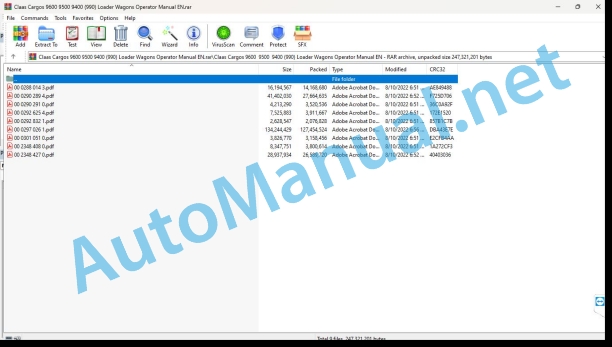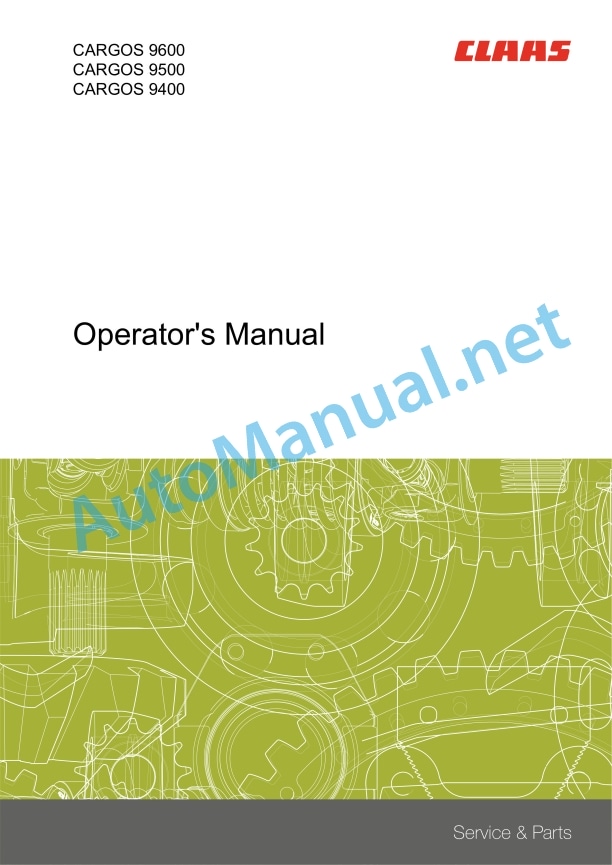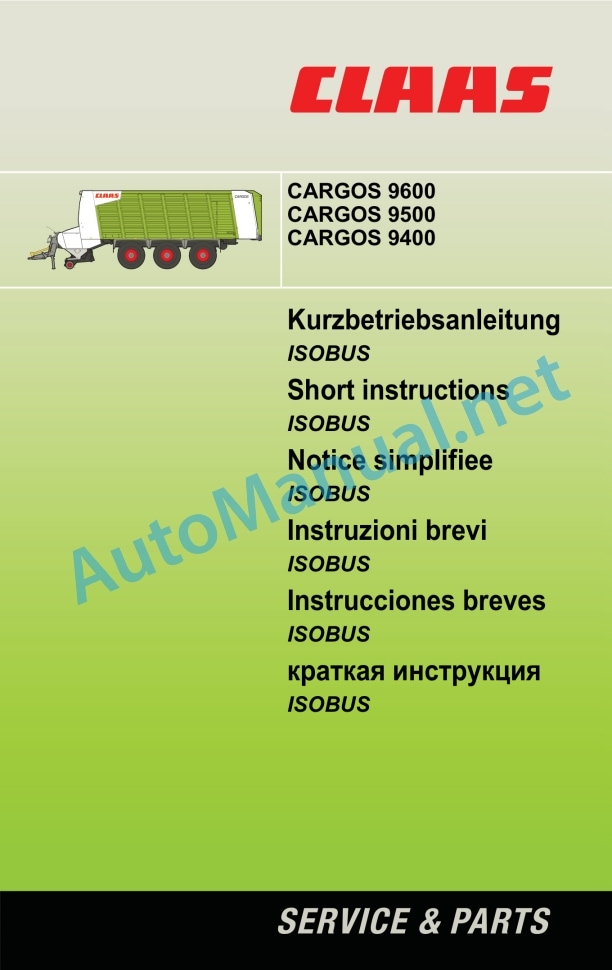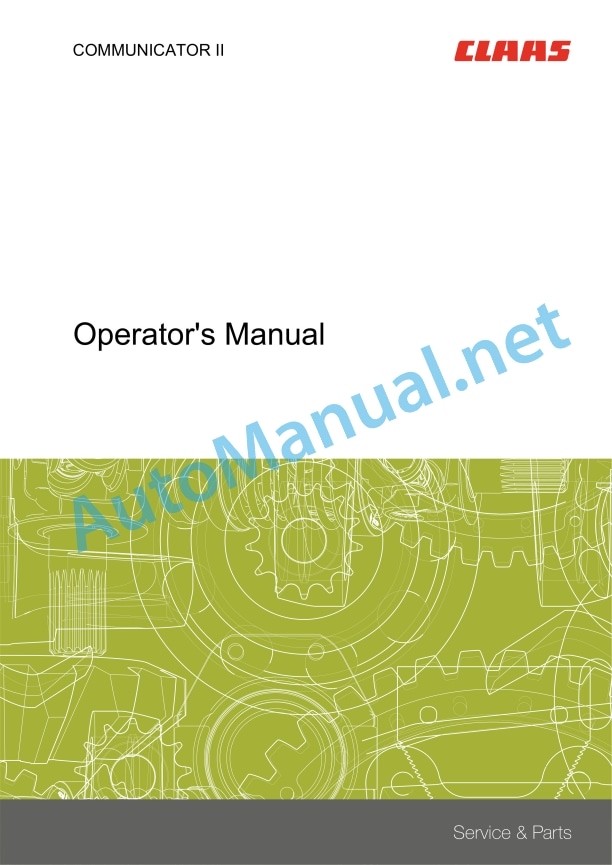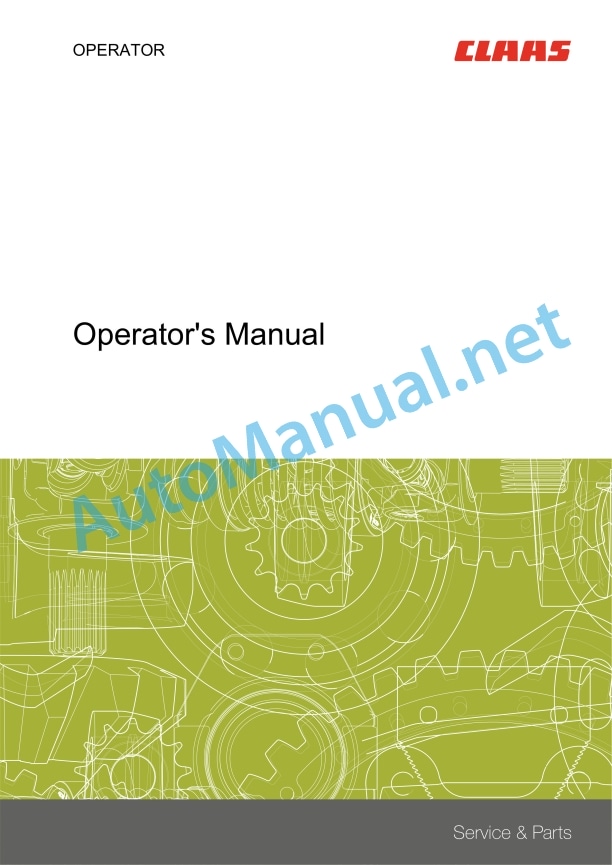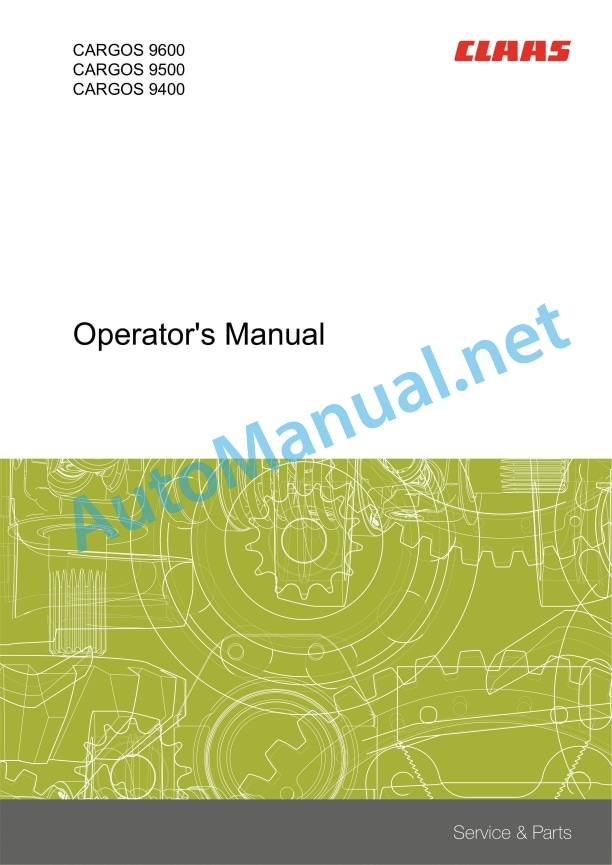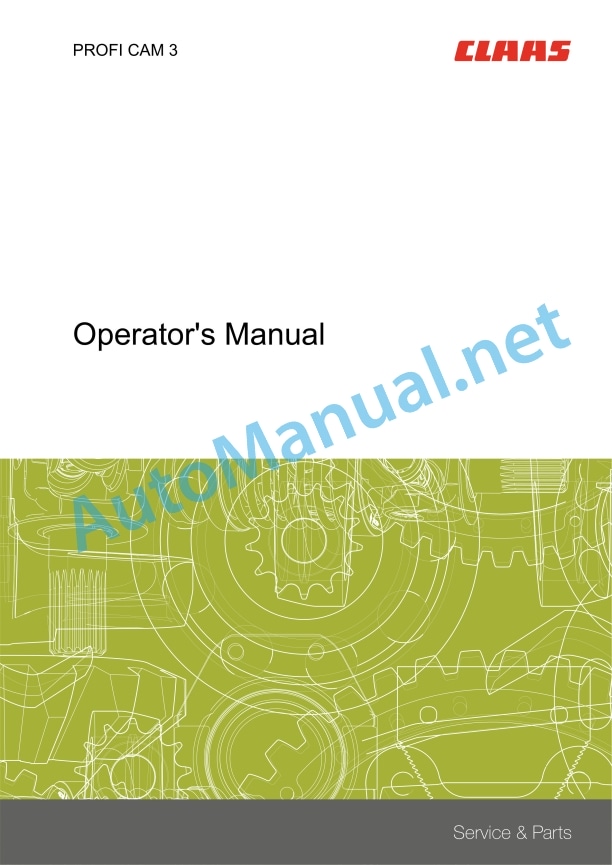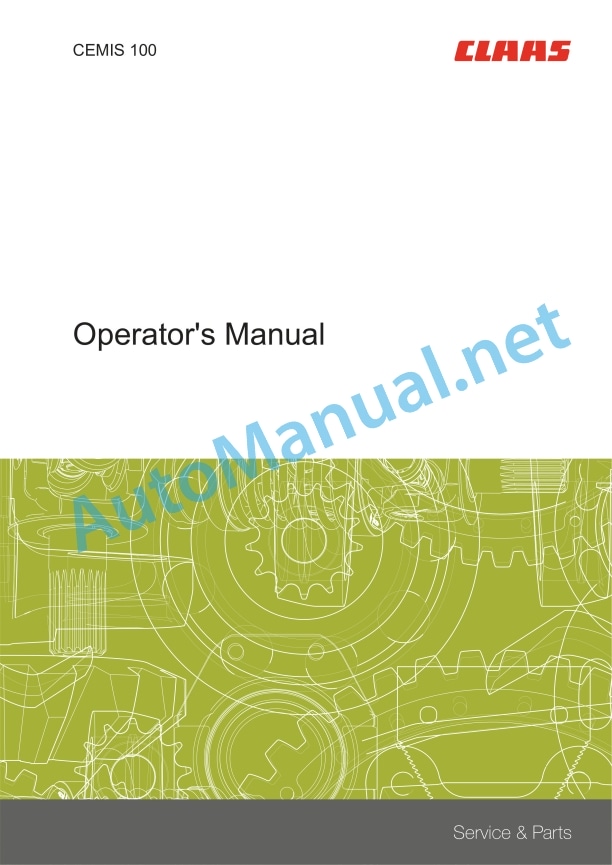Claas Cargos 9600 9500 9400 (990) Loader Wagons Operator Manual EN
$50.00
- Model: Cargos 9600 9500 9400 (990) Loader Wagons
- Type Of Manual: Operator Manual
- Language: EN
- Format: PDF(s)
- Size: 203 MB
File List:
00 0288 014 3.pdf
00 0290 289 4.pdf
00 0290 291 0.pdf
00 0292 625 4.pdf
00 0292 832 1.pdf
00 0297 026 1.pdf
00 0301 051 0.pdf
00 2348 408 0.pdf
00 2348 427 0.pdf
00 0288 014 3.pdf:
EASY on board app
Table of contents
1 Introduction
1.1 General information
1.1.1 Validity of the manual
1.1.2 Information about this Operator’s Manual
1.1.3 Symbols and notes
1.1.4 Qualified specialist workshop
1.1.5 Maintenance notes
1.1.6 Notes on warranty
1.1.7 Spare parts and technical questions
1.1.8 Technical requirements
1.2 Intended use
1.2.1 Intended use
1.2.2 Reasonably foreseeable misuse
2 Safety
2.1 Identifying warnings
2.1.1 Hazard signs
2.1.2 Signal word
2.2 Safety rules
2.2.1 Meaning of Operator’s Manual
2.2.2 Requirements made on all persons working with the product
2.2.3 Hazard areas
2.2.4 Check interactions with self-propelled machines / tractors and implements
2.2.5 Structural changes
2.2.6 Optional equipment and spare parts
2.2.7 Technical status
2.2.8 Hazard caused by damage to the product
2.2.9 Visibility of work area
2.2.10 Glare and reflections
2.2.11 Unintentional triggering of functions
2.2.12 Hazards caused by signal tones
2.2.13 Unauthorised use
2.2.14 Use of mobile terminal outside the cab
2.2.15 Follow the safety instructions
2.2.16 Respecting technical limit values
2.2.17 Preparing the product for road travel
2.2.18 Hazards when driving on the road and on the field
2.2.19 Hazards when driving on the road with an ISOBUS implement
2.2.20 Switching off the mobile terminal while driving
2.2.21 Hazards from disturbance of WLAN environment
2.2.22 Hazards from covering up the App
2.2.23 Hazards caused by malfunctions of the app
2.2.24 Raised machine parts and loads
3 Product description
3.1 Overview and method of operation
3.1.1 Overview of CWI
3.1.2 Functions of CWI
3.2 Identification plates and identification numbers
3.2.1 CWI identification plate
3.3 Information on the product
3.3.1 Factory settings
3.3.2 Software and hardware version
3.3.3 Seal on the CWI
4 Operating and display elements
4.1 CLAAS Wireless Interface (CWI)
4.1.1 CWI operating elements
4.2 CWI Setup App
4.2.1 Overview of screen
4.2.2 Buttons
4.2.3
4.2.4
4.2.5
5 Technical specifications
5.1 CLAAS Wireless Interface (CWI)
5.1.1 Specification
6 Preparing the product
6.1 Installing the product
6.1.1 Installing the CWI Setup app
6.1.2 Installing the EASY on board app
6.1.3 Connecting the tablet
7 Operation
7.1 Initial operation
7.1.1 Establishing the WLAN connection for the first time
7.1.2 Changing factory settings
7.1.3 Establishing the WLAN connection
7.2 CWI Setup App
7.2.1 Calling up menus
7.2.2 Establishing a secure data connection
7.2.3 Deleting a secure data connection
7.2.4 Displaying the software version
7.3 CWI Setup – Settings
7.3.1 Changing settings
7.3.2 Switching LEDs on and off
7.4 CWI setup – Advanced settings
7.4.1 Deleting the connection partner in CWI
7.4.2 Deleting the connection partner on the tablet
7.4.3 Resetting the CWI to factory settings
7.4.4 Resetting the tablet to factory settings
7.4.5 Switching the CAN filter on and off
7.5 EASY on board App
7.5.1 Launching Operator’s Manual
8 Faults and remedies
8.1 Overview of problems
8.1.1 CWI faults
8.1.2 Fault message: USB charging connection was disconnected
8.1.3 Fault message: Tablet outside WLAN reception area
8.1.4 Fault message: Screen locked
9 Maintenance
9.1 Maintenance schedules
9.1.1 Daily
9.2 Tablet
9.2.1 Cleaning the tablet
9.2.2 Downloading software updates
9.2.3 Updating the operating system
10 Putting out of operation and disposal
10.1 General information
10.1.1 Decommissioning and disposal
11 EC declaration of conformity
11.1 CLAAS Wireless Interface (CWI)
11.1.1 EU Declaration of conformity
12 Technical terms and abbreviations
12.1 Terms and explanations
12.1.1 Abbreviations
12.1.2 Technical terms
00 0290 289 4.pdf:
CARGOS 9600CARGOS 9500CARGOS 9400
Table of contents
1 To this Operator’s Manual
1.1 Notes on the manual
1.1.1 General instructions
1.1.2 Validity of manual
1.1.3 Technical specifications
1.1.4 Symbols and notes
1.1.5 Using the manual
Directions
2 Safety
2.1 Safety rules
2.1.1 Particularly important
2.1.2 Qualification of drivers and maintenance personnel
2.1.3 Intended use
2.1.4 Reasonably foreseeable misuse
2.1.5 Safety and accident prevention regulations
2.1.6 First aid measures
2.1.7 Danger of injury from hydraulic liquid
2.2 Safety decals on the machine
2.2.1 Safety decals
2.2.2 Position of safety decals
3 Machine description
3.1 Overview and method of operation
3.1.1 Combi-wagon with tridem axle assembly
3.1.2 Combi-wagon with Tandem axle assembly
3.1.3 How the machine works
Function of self-loading and silage wagon
Function of transport wagon
3.2 Access to the work area and maintenance areas
3.2.1 Loading space
3.3 Optional machine equipment
3.3.1 Hydraulic coupling as per ISO 16028
3.3.2 Slip yoke
3.3.3 Tail section with removed proportioning rollers
3.3.4 Channel cover
3.3.5 Chopping wagon conversion kit
3.3.6 Pick-up: Additional touch wheel
3.3.7 Central lubrication system
3.3.8 Filling level sensor
3.3.9 Dummy knives set
3.3.10 PROFI CAM 3
3.3.11 Work lighting
3.3.12 LED work lighting
3.3.13 Side marker lights
3.3.14 Battery cable*
3.3.15 Order printer for ISOBUS
3.3.16 Load weight indicator
3.3.17 Torque-controlled unloading
3.4 Identification plates and identification number
3.4.1 Spare parts and technical questions
3.4.2 Position of identification plates
3.4.3 Position of identification number
3.4.4 Explanation of machine identification plate
4 Operating and control elements
4.1 Exterior operator panel
4.1.1 Articulated drawbar and cutting trough
4.2 Display elements
4.2.1 Forced steering pressure gauge
4.2.2 Forced steering pressure gauge
4.2.3 Cock
4.2.4 Pick-up load relief pressure gauge*
4.2.5 PROFI CAM 3* monitor
4.3 CLAAS COMMUNICATOR
4.3.1 Overview
4.4 ISOBUS control unit
4.4.1 Screen
4.4.2 Title Bar
4.4.3 Menu Bar
4.4.4 Data Field
4.4.5 Status bar
4.4.6 Softkey
4.4.7 Softkeys – overview
Transport menu
Loading menu
Loading – automatic operation sub-menu
Loading – manual operation sub-menu
Unloading menu
Unloading – automatic operation sub-menu
Unloading – manual operation sub-menu
4.4.8 Program version
5 Technical specifications
5.1 CARGOS 9600 – model 990
5.1.1 Dimensions
5.1.2 Weights
5.1.3 Pick-up
5.1.4 Cutterbar
5.1.5 Tyre pressure
5.1.6 Requirements of the tractor
5.1.7 Electrical system
5.1.8 PTO speed
5.1.9 Sound pressure level
5.1.10 Lubricants
5.2 CARGOS 9500 – model 990
5.2.1 Dimensions
5.2.2 Weights
5.2.3 Pick-up
5.2.4 Cutterbar
5.2.5 Tyre pressure
5.2.6 Requirements of the tractor
5.2.7 Electrical system
5.2.8 PTO speed
5.2.9 Sound pressure level
5.2.10 Lubricants
5.3 CARGOS 9400 – model 990
5.3.1 Dimensions
5.3.2 Weights
5.3.3 Pick-up
5.3.4 Cutterbar
5.3.5 Tyre pressure
5.3.6 Requirements of the tractor
5.3.7 Electrical system
5.3.8 PTO speed
5.3.9 Sound pressure level
5.3.10 Lubricants
6 Machine preparation
6.1 Shutting down and securing the machine
6.1.1 Switching off and securing machine
6.2 Assembling the machine
6.2.1 Overview of shipping package
6.2.2 Removing individual parts from the loading space
Opening the access opening
Closing the access opening
6.2.3 Stowing the ladder
6.2.4 Stowing the wheel chocks
6.2.5 Fitting the universal drive shaft to the machine
6.2.6 Connecting the ISOBUS cable
6.2.7 Fitting optional machine equipment
6.3 Access to workplace and maintenance positions
6.3.1 Accessing the loading space
6.3.2 Leaving the loading space
6.4 Adapting the tractor
6.4.1 Hitching for positive steering
6.4.2 Configuring the tractor air brake system
6.4.3 Fitting the bracket for the CLAAS COMMUNICATOR
6.4.4 Installing the CLAAS COMMUNICATOR
6.5 Adapting the machine
6.5.1 Adjusting positive steering
6.5.2 Use as a transport wagon
6.5.3 Removing the loading and cutting unit
Coupling and uncoupling central lubrication system*
6.5.4 Removing the proportioning roller unit
6.5.5 Fitting the dummy knife set*
6.5.6 Connecting the hydraulic hose lines
Closed hydraulic system (load sensing) with load-sensing control line:
Open hydraulic system or closed hydraulic system without load-sensing control line:
Connecting the hydraulic hose line (P1)
6.5.7 Adapting the hydraulic system
Closed hydraulic system (constant-pressure or load-sensing)
Open hydraulic system (standard system)
6.5.8 Adjusting the hydraulic articulated drawbar
6.5.9 Adjusting the hydropneumatic chassis
6.5.10 Central lubrication system*: Filling the lubricant reservoir
6.6 Coupling the machine to the tractor
6.6.1 General instructions
6.6.2 Connecting the cable for the driving lights
6.6.3 Installing the ISOBUS cable
6.6.4 Hitching the drawbar
6.6.5 Raising the stand
6.6.6 Coupling the positive steering
Basic setting
Adjusting the tow bar
Coupling tow bar
Positive steering protector shield
6.6.7 Positive steering: Checking hydraulic pressure
6.6.8 Universal drive shaft:Checking the length
Universal drive shaft – shortest operating position
Universal drive shaft – longest operating position
6.6.9 Universal drive shaft:Adapting the length
6.6.10 Fitting the universal drive shaft
6.6.11 Connecting the compressed air brake*
6.6.12 Connecting the hydraulic brake*
6.6.13 Actuating the parking brake
6.6.14 Remove the wheel chock
6.7 Unhitching the machine from the tractor
6.7.1 Information to be observed
6.7.2 Positioning the wheel chock at the wheel
6.7.3 Apply the parking brake.
6.7.4 Unhitching the forced steering
6.7.5 Extending the stand
6.7.6 Unhitching the drawbar
6.7.7 Removing the universal drive shaft
6.7.8 Disconnecting the electric system
6.7.9 Removing the CLAAS COMMUNICATOR
6.7.10 Removing the ISOBUS cable
6.7.11 Disconnecting the hydraulic hoses
6.7.12 Disconnecting the compressed-air operated brake
6.7.13 Disconnecting hydraulically-operated brakes
6.8 Loading and lashing down the machine
6.8.1 Loading and lashing down the machine
7 Operation
7.1 Driving with the combi-wagon
7.1.1 Checking before travel
7.1.2 Ladder:Swinging in the bracket
7.1.3 Activating hydraulic drawbar damping
7.1.4 Raising and lowering the lift axle
7.1.5 Manoeuvring the combi-wagon with tractor without compressed-air system
7.1.6 Locking the trailing steering axle
7.2 Driving on the road
7.2.1 General instructions
7.2.2 Driving licence categories required for Germany
7.2.3 Documents to be carried on the machine
7.2.4 Modifications to the machine
7.2.5 Licence and registration requirements
7.2.6 Regular inspection according to § 29 StVZO (German Road Traffic Regulations)
7.2.7 Operating on public roads
7.2.8 Work lights
7.3 Adjusting before loading
7.3.1 Adjusting before loading
7.3.2 Adjusting the pick-up working height
7.3.3 Adjusting the pick-up load relief*
7.3.4 Setting the baffle plate
7.3.5 Adjusting the length of cut
7.3.6 Adjusting the roof panel
7.4 Loading the wagon
7.4.1 Filling the loading space evenly
7.4.2 Loading process
7.5 Unloading the waon
7.5.1 Open tailgate
7.5.2 Operating the removal plate
7.6 ISOBUS control unit
7.6.1 Description
7.6.2 General instructions
7.6.3 Changing between menus
Notes on automatic operation
Changing the main menu
Changing the sub-menu
Exiting sub-menus
7.7 Switching the ISOBUS terminal on/off
7.7.1 Switching on the ISOBUS terminal
Error when loading the control programme
7.7.2 Starting the control programme
7.7.3 Switching off the terminal
7.8 ISOBUS transport
7.8.1 Activating the transport position automatically
7.8.2 Activating the transport position manually
7.8.3 Adjusting the articulated drawbar
7.8.4 Activating the drawbar damping
7.8.5 Lifting / lowering the axle
7.8.6 Locking and unlocking the trailing steering axle*
7.8.7 Opening / closing the roof panel
7.8.8 Switching work lighting on/off
7.9 Loading – automatic operation ISOBUS
7.9.1 Calls up the Loading – automatic operation sub-menu
7.9.2 On the turning area
Turning area position
Working position
7.9.3 Floor conveyor control system* – loading
Torque display (M)
Switching the floor conveyor drive on/off automatically
Adjusting threshold value
Increasing the baling pressure
7.9.4 Switching on the floor conveyor briefly
7.9.5 Lifting / lowering the pick-up
7.9.6 Feed chute – removing blockages
7.9.7 Filling level display*
7.9.8 Wagon full message
7.9.9 Loading – terminating the automatic operating mode
7.9.10 Automatic light
7.10 Loading – manual operation ISOBUS
7.10.1 General instructions
7.10.2 Loading the machine manually
7.10.3 Calling up the Loading – manual operation sub-menu.
7.10.4 Opening / closing the cutting trough
7.10.5 Increasing / reducing the speed of the floor conveyor
7.10.6 Switching the loading space lighting / work lights on/off
7.10.7 Switching pickup on/off
7.10.8 Reversing the floor conveyor drive
7.10.9 Loading – ending manual operation
7.11 Unloading – automatic operation ISOBUS
7.11.1 Calling up the Unloading – automatic operation sub-menu
7.11.2 Floor conveyor control system* – unloading
Torque display (M)
Switching the floor conveyor drive on/off automatically
Adjusting threshold value
7.11.3 Switching floor conveyor drive on/off
7.11.4 Residual wagon emptying (only on wagons with proportioning rollers)
7.11.5 Increasing / reducing the speed of the floor conveyor
7.11.6 Floor conveyor control system* – Adjusting unloading
7.11.7 Unloading – ending automatic operation
7.12 Unloading – manual operation ISOBUS
7.12.1 General instructions
7.12.2 Unloading the machine manually
7.12.3 Calling up the Unloading – manual operation sub-menu.
7.12.4 Opening / closing the tailgate
7.12.5 Operating the removal plate
7.12.6 Switching proportioning roller drive* on/off
7.12.7 Unloading – ending manual operation
7.13 ISOBUS work record management
7.13.1 Calling up work record data
7.13.2 Activating / deactivating a work record
7.13.3 Exiting the Work record management sub-menu.
7.13.4 Creating a work record
7.13.5 Data entry sub-menu
7.14 ISOBUS settings
7.14.1 General instructions
7.14.2 Calling up the Settings sub-menu.
7.14.3 Settings sub-menu data field
7.14.4 Changing threshold value, floor conveyor speed and opening angle
7.14.5 Changing the baling pressure
7.14.6 Restoring the factory settings
7.14.7 Saving the articulated drawbar settings
7.14.8 Exiting the Articulated drawbar settings sub-menu
7.14.9 Resetting the maintenance counter
7.14.10 Switching on/off the ensiling agent feed
7.14.11 Central lubrication system* – Set lubrication interval
7.14.12 Exiting the Settings sub-menu
7.15 ISOBUS information
7.15.1 General instructions
7.15.2 Calls up the Information sub-menu
7.15.3 Information sub-menu data field
Fault message symbols
7.15.4 Sensor installation positions
7.16 ISOBUS Auxiliary“ function (AUX)
7.16.1 Available functions
7.16.2 Example of use
7.17 ISOBUS basic setting (initialisation)
7.17.1 General instructions
7.17.2 Calling up the Initialisation sub-menu
7.17.3 Learning the end stops.
7.17.4 Torque-controlled unloading*
7.18 ISOBUS operation option – Fendt
7.18.1 Using the tractor terminal
7.18.2 Tractor terminal and joystick
7.18.3 Joystick and CLAAS COMMUNICATOR
7.19 CLAAS COMMUNICATOR*
7.19.1 Notes relating to this chapter
7.19.2 Recommendations for optimum use
7.20 Switching the CLAAS COMMUNICATOR* on/off
7.20.1 Switching on the CLAAS COMMUNICATOR*
7.20.2 Switching the CLAAS COMMUNICATOR* off
7.21 Operating the CLAAS COMMUNICATOR*
7.21.1 Select menu“ / cancel key (ESC)
7.21.2 Function keys
7.21.3 Select wheel – data selection and data input
7.21.4 Text input menu
7.21.5 Nation in the data field
7.21.6 Programmable keys
7.21.7 Software maintenance
7.22AS COMMUNICATOR* service program
7.22.1 Scope of functions
7.22.2 Calling up the service program
7.23 CLAAS COMMUNICATOR* menu descriptions
7.23.1 Changing the menu
7.23.2 Information menu
7.23.3 Brightness / contrast menu
7.23.4 Time and date menu
7.23.5 Memory management menu
7.23.6 Diagnosis sub-menu
7.23.7 Country settings menu
7.23.8 Auxiliary function (AUX-O) menu
7.23.9 Key assignment sub-menu
7.24 CLAAS COMMUNICATOR* programmable keys
7.24.1 Introduction
7.24.2 Assigning a function to a key
7.24.3 Deleting a key assignment
7.24.4 Changing key assignment
8 Faults and remedies
8.1 Emergency operation
8.1.1 Operating hydraulic valves manually
8.2 ISOBUS fault messages
8.2.1 Sensor fault
8.2.2 PTO shaft engaged message
8.2.3 Fault finding
8.2.4 General faults
8.2.5 Fault code table
8.3 Central lubrication system
8.3.1 Fault and remedy for central lubrication system*
9 Maintenance
9.1 Maintenance Information
9.1.1 General instructions
9.1.2 Bolts
9.1.3 Lubrication
9.1.4 Brakes
9.1.5 Wheels
9.1.6 Lines, tubes and hoses
9.1.7 Electrical system
9.1.8 Compressed air and water
9.1.9 Burn prevention
9.1.10 Oils
9.1.11 Fire prevention and explosion prevention
9.1.12 Guards
9.1.13 Spare parts
9.2 Overview maintenance intervals
9.2.1 Dealing with maintenance intervals
9.2.2 Before the harvest
9.2.3 After the first 10 operating hours
9.2.4 After the first 50 operating hours
9.2.5 Every 8 operating hours or daily
9.2.6 Every 20 operating hours
9.2.7 Every 40 operating hours
9.2.8 Every 50 operating hours
9.2.9 Every 60 operating hours
9.2.10 Every 100 operating hours
9.2.11 Every 250 operating hours
9.2.12 Every 500 operating hours or annually
9.2.13 Every 1000 operating hours or every 2 years
9.2.14 As needed
9.2.15 After the harvest
9.3 Maintenance operations in general
9.3.1 Clean machine
9.3.2 Preserve the machine
9.3.3 Checking the fittings
9.3.4 Remove any crop residue
9.4 Gearbox
9.4.1 Check gearbox tightness
9.4.2 Main gearbox: Checking the oil level
9.4.3 Main gearbox: Changing the oil
9.4.4 Rotor gearbox: Checking the oil level
9.4.5 Rotor gear: Changing the oil
9.4.6 Rear proportioning roller gearbox: Changing the oil
9.4.7 Front top proportioning roller gearbox: Checking the oil level
9.4.8 Front top proportioning roller gearbox: Changing the oil
9.4.9 Front bottom proportioning roller gearbox: Checking the oil level
9.4.10 Front bottom proportioning roller gearbox: Changing the oil
9.4.11 Floor conveyor gearbox: Check the oil level
9.4.12 Floor conveyor gearbox: Change the oil
9.5 Clutch
9.5.1 General instructions
9.5.2 Pick-up: Adjusting the cut-out clutch
9.5.3 Check the overload clutch
9.5.4 Check the overload clutch
9.6 Universal drive shaft
9.6.1 Maintaining drive shafts
9.6.2 Removing the power take-off shaft guard
9.6.3 Fitting the power take-off shaft guard
9.7 Chassis
9.7.1 Checking the tyre air pressure
9.7.2 Retighten the wheel nuts
9.7.3 Changing the wheel
9.7.4 Hydropneumatic chassis*: Checking the cylinder attachment
9.7.5 Steering axle: Checking the gas shock absorbers
9.8 Brake
9.8.1 Brake system: Carrying out a visual check
9.8.2 Brake system: Carrying out a functional check
9.8.3 Draining the compressed air reservoir*
9.8.4 Cleaning the pipe filter*
9.8.5 Compressed air brake system: Checking the brake cylinder piston stroke
9.9 Forced steering system
9.9.1 Adjusting positive steering
9.9.2 Adjusting the control cylinder
1st axle
If the dimension X is less than 145 mm:
3rd axle
If the dimension X is more than 145 mm:
9.9.3 Adjusting the control cylinder
If the dimension X is less than 145 mm:
If the dimension X is more than 145 mm:
9.9.4 Adjusting tow bar
9.9.5 Bleed forced steering
9.9.6 Preparing for bleeding
9.9.7 Bleeding control cylinder upper chamber
1st axle
3rd axle
9.9.8 Bleeding control cylinder upper chamber
9.9.9 Bleeding control cylinder lower chamber
1st axle
3rd axle
9.9.10 Bleeding control cylinder lower chamber
9.9.11 Bleeding the steering axle hydraulic cylinder
1st axle
3rd axle
9.9.12 Bleeding the steering axle hydraulic cylinder
9.9.13 Completing bleeding operation
1st axle
3rd axle
9.9.14 Completing bleeding operation
9.9.15 Positive steering: Checking hydraulic pressure
9.10 Hitch
9.10.1 Stand: Checking the screws
9.11 Drives
9.11.1 Maintaining chains
9.11.2 Tensioning the drive chains
9.11.3 Pick-up: Tensioning the drive chain
9.11.4 Proportioning rollers: Checking the chain tensioners
9.11.5 Proportioning rollers: Adjusting the chain tensioners
9.12 Hydraulic system
9.12.1 Hydraulic system maintenance
9.12.2 Check the hydraulic hoses
9.12.3 Replacing the hydraulic oil filter
9.13 Maintenance electrical / electronics
9.13.1 Main drive: Adjusting the speed monitor
9.13.2 Proportioning rollers: Adjusting the speed sensor
9.13.3 Proportioning rollers: Adjusting the detection sensor
9.13.4 Door locking mechanism: Adjusting the sensor
9.13.5 Wagon full indicator: Adjusting the sensor
9.13.6 Tailgate: Adjusting the position sensor
9.13.7 Tailgate: Adjusting the sensor
9.13.8 Check lighting
9.14 Pick-up
9.14.1 Checking the guide rollers
9.15 Cutter housing
9.15.1 Check knives
9.15.2 Removing the knives
9.15.3 Installing the knives
Adjust the distance from the tip of the knife to the rotor wall
9.15.4 Adjusting the cutting trough
Removing stress in the cutting trough
Relocating the cutting trough to the right
Relocating the cutting left trough to the left
Adjusting the guide bolts on the left and right
9.15.5 Adjusting knife guide
Adjusting the play between knives and eccentric shaft
9.15.6 Adjusting the stripper housing
9.15.7 Cleaning the cutting trough
9.16 Floor conveyor
9.16.1 Checking the feed rake slats
9.16.2 Tensioning the floor conveyor chains
9.16.3 Removing chain links
9.17 Central lubrication
9.17.1 Central lubrication system*
9.17.2 Checking the central lubrication system*
9.17.3 Central lubrication system*: Filling lubricant reservoir
9.17.4 Switching on the central lubrication system manually.
9.17.5 Lubricating the central lubrication system* manually
9.18 Attachment parts
9.18.1 Headlights
9.18.2 Check wheel chocks
9.18.3 Check ladder
9.19 Covers
9.19.1 Opening / closing covers
Front covers
Opening the front covers
Closing the front covers
Opening the top front covers
Closing the top front covers
Lateral covers
Opening the front side covers (9)
Closing the front side covers (9)
Opening the front side covers (10)
Closing the front side covers (10)
Rear lateral covers
Opening the rear lateral covers
Closing the rear lateral covers
9.19.2 Covers: Checking the gas shock absorbers
9.20 Lubrication chart – without central lubrication system*
9.20.1 Lubrication points – 8 h
9.20.2 Lubrication points – 20 h
9.20.3 Grease points- 40 h
9.20.4 Grease points- 60 h
9.20.5 Grease points – 100 h
9.20.6 Grease points- 200 h
9.20.7 Grease points – 250 h
9.20.8 Grease points- 500 h
9.21 Lubrication chart – with central lubrication system*
9.21.1 Lubrication points – 20 h
9.21.2 Grease points- 40 h
9.21.3 Grease points- 60 h
9.21.4 Grease points – 100 h
9.21.5 Grease points- 200 h
9.21.6 Grease points – 250 h
9.21.7 Grease points- 500 h
10 Placing out of operation and disposal
10.1 General Information
10.1.1 Putting out of operation and disposal
11 EC declaration of conformity
11.1 EC Declaration of Conformity
12 Technical terms and abbreviations
12.1 Terms and explanations
12.1.1 Technical terms
12.1.2 Abbreviations
00 0292 625 4.pdf:
COMMUNICATOR II
Table of contents
1 Introduction
1.1 Notes on the manual
1.1.1 Validity of manual
1.1.2 Information about this Operator’s Manual
1.1.3 Symbols and notes
1.1.4 Optional equipment
1.1.5 Qualified specialist workshop
1.1.6 Maintenance notes
1.1.7 Notes on warranty
1.1.8 Spare parts and technical questions
1.2 Intended use
1.2.1 Intended use
1.2.2 Reasonably foreseeable misuse
2 Safety
2.1 Identifying warnings
2.1.1 Hazard signs
2.1.2 Signal word
2.2 Safety rules
2.2.1 Meaning of Operator’s Manual
2.2.2 Requirements made on all persons working with the product
2.2.3 Hazard areas
Hazard areas
2.2.4 Interaction between the control terminal and the machine or tractor
2.2.5 Structural changes
2.2.6 Optional equipment and spare parts
2.2.7 Technical status
2.2.8 Danger from damage to the machine
2.2.9 Complying with technical limit values
2.2.10 Preparing the product for road travel
2.2.11 Hazards when driving on the road and in the field
2.2.12 Hazards when driving on the road with an ISOBUS implement
2.2.13 Switching off the terminal while driving
2.2.14 Electrocution by electrical system
2.2.15 Only carry out work on the machine when it is stopped
2.2.16 Maintenance operations and repair work
2.2.17 Raised machine parts and loads
2.2.18 Welding work prohibited
3 Product description
3.1 Overview and method of operation
3.1.1 Overview of COMMUNICATOR II
3.1.2 Function of COMMUNICATOR II
3.2 Identification plates and identification numbers
3.2.1 Identification plate of COMMUNICATOR II
4 Operating and display elements
4.1 COMMUNICATOR II
4.1.1 Terminal
4.1.2 Terminal program
4.2 Universal terminal menu structure (service)
4.2.1 Main menu of universal terminal
4.2.2
4.2.3
4.2.4
4.2.5
4.3 Job processing (task) menu structure
4.3.1 Job processing main menu
4.3.2
4.3.3
4.3.4
4.3.5
4.3.6
5 Technical specifications
5.1 COMMUNICATOR II
5.1.1 Specification
6 Preparing the product
6.1 Switching off and securing the machine
6.1.1 Shut down and secure the machine
7 Operation
7.1 Switching COMMUNICATOR II on/off
7.1.1 Switching COMMUNICATOR II on
7.1.2 Selecting the application
7.1.3 Switching off COMMUNICATOR II
7.2 Programmable keys
7.2.1 Displaying the key assignment
7.2.2 Creating a key assignment
Step 1: Selecting the control and the key
00 0292 832 1.pdf:
OPERATOR
Table of contents
1 To this Operator’s Manual
1.1 Notes on the manual
1.1.1 Validity of the manual
1.1.2 Using the manual
1.1.3 Symbols and notes
1.1.4 Technical specifications
2 Safety
2.1 Safety rules
2.1.1 Particularly important
2.1.2 Intended use
2.1.3 Reasonably foreseeable misuse
2.1.4 General safety and accident prevention regulations
3 Product description
3.1 Overview and method of operation
3.1.1 OPERATOR overview
3.1.2 OPERATOR mode of operation
3.2 Identification plates and identification numbers
3.2.1 Spare parts and technical questions
3.2.2 OPERATOR identification plate
4 Operating and display elements
4.1 CLAAS OPERATOR
4.1.1 Terminal
4.1.2 Terminal program
4.1.3 Menu overview
4.1.4 Information menu
4.1.5 Settings menu
4.1.6 Time menu
4.1.7 Diagnosis menu
4.1.8 Language and units menu
5 Technical specifications
5.1 CLAAS OPERATOR
5.1.1 Specification
6 Operation
6.1 Switching the OPERATOR on and off
6.1.1 Switching on the OPERATOR
6.1.2 Selecting
John Deere Repair Technical Manual PDF
John Deere Parts Catalog PDF
John Deere Tractors 7500 Parts Catalog CPCQ26568 30 Jan 02 Portuguese
John Deere Repair Technical Manual PDF
John Deere Repair Technical Manual PDF
John Deere Repair Technical Manual PDF
John Deere PowerTech M 10.5 L and 12.5 L Diesel Engines COMPONENT TECHNICAL MANUAL CTM100 10MAY11
John Deere Repair Technical Manual PDF
John Deere Parts Catalog PDF
John Deere Tractors 6300, 6500, and 6600 Parts Catalog CQ26564 (29SET05) Portuguese
John Deere Repair Technical Manual PDF
John Deere Application List Component Technical Manual CTM106819 24AUG20
John Deere Repair Technical Manual PDF
John Deere 16, 18, 20 and 24HP Onan Engines Component Technical Manual CTM2 (19APR90)
John Deere Repair Technical Manual PDF
John Deere DF Series 150 and 250 Transmissions (ANALOG) Component Technical Manual CTM147 05JUN98

